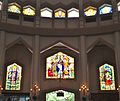Antipolo Cathedral
This article needs additional citations for verification. (February 2013) |
| Antipolo Cathedral | |
|---|---|
| Cathedral of the Immaculate Conception of Antipolo National Shrine of Our Lady of Peace and Good Voyage | |
 The façade of Antipolo Cathedral in 2014 | |
| Location | Antipolo City, Rizal |
| Country | |
| Denomination | Roman Catholic |
| History | |
| Status | Cathedral |
| Founded | 1632 |
| Founder(s) | Juan de Salazar, S.J. |
| Dedication | Our Lady of Peace and Good Voyage |
| Architecture | |
| Functional status | Active |
| Architect(s) | José L. De Ocampo |
| Architectural type | Church building |
| Completed | 1954 |
| Specifications | |
| Number of domes | 1 |
| Number of spires | 1 |
| Materials | Cement |
| Administration | |
| Diocese | Antipolo |
| Clergy | |
| Bishop(s) | Most Rev Gabriel V. Reyes |
The Antipolo Cathedral (formal title: Cathedral of the Immaculate Conception of Antipolo, also known as the National Shrine of Our Lady of Peace and Good Voyage) is a Roman Catholic cathedral located in Antipolo City, Rizal in the Philippines. It enshrines the Marian image of Our Lady of Peace and Good Voyage (Spanish: Nuestra Señora de la Paz y Buen Viaje), and is the seat of the Bishop of Antipolo.[1]
The shrine attracts millions of pilgrims annually, especially on the eve of 1 May.
History
The first church in what is now Antipolo City was built by the Society of Jesus under Rev Juan de Salazar. The church, meant to house the image of Our Lady of Peace and Good Voyage brought by then-Governor General Juan Niño de Tabora, was supposed to be built on a different plot of land. The church's present location was the site of the tipolo (Artocarpus blancoi), top which the image was found after mysteriously vanishing several times.[2]
The church was completed in 1632, but suffered severe damage in 1639 when the Sangley (Chinese) set fire to the church in a revolt. It was restored afterwards though it was damaged by the 1645 Luzon earthquake, and other earthquakes in 1824 and 1863. Nevertheless, the church became a popular pilgrimage site as many devotees paid reverence to Our Lady of Peace and Good Voyage,[3] including Philippine national hero and polymath José Rizal, who visited the shrine as a boy with his father, Francisco Mercado, on 6 June 1868. The pair went on pilgrimage to fulfil a vow Rizal's mother, Teodora Alonso, had made when she and the boy survived his delivery.[4]
Towards the end of the Second World War in 1945, the church was destroyed by Allied bombardment meant to liberate the area from the Japanese Imperial control. After the war, a campaign was organised to build a new church, with the fundraising committee headed by former First Lady Aurora Quezon and Antipolo parish priest, Francisco Avendano. Architect José L. de Ocampo was commissioned to design the new shrine, which was completed in 1954.[2]
On 14 January 1954, the Catholic Bishops Conference of the Philippines declared the new Antipolo Church as declared the National Shrine to Our Lady of Peace and Good Voyage. The church was elevated to the status of cathedral on 25 June 1983, upon the canonical erection of the Diocese of Antipolo.
Gallery
-
High altar, with the image of Our Lady of Peace and Good Voyage enshrined behind glass.
-
Stained glass windows above one of the main doors
-
Bas-relief in painted wood depicting the first arrival of Our Lady of Peace and Good Voyage in the Philippines
-
Cathedra of the Bishop of Antipolo
-
The cathedral's façade from the northwest
-
The cathedral's façade from the southwest
References
- ^ "Diocese of Antipolo". CBCP Online.
- ^ a b "History". Antipolo: The City of Pilgrimage.
- ^ Mercado, Monina (1980). Antipolo: A Shrine To Our Lady. Makati: Craftnotes for Aletheia Foundation.
- ^ Jose Rizal University (2004). "In Calamba, Laguna". JoseRizal.ph. Retrieved 1 May 2015.
6 June 1868 With his father, Rizal made a pilgrimage to Antipolo to fulfill the vow made by his mother to take the child to the Shrine of the Virgin of Antipolo should she and her child survive the ordeal of delivery which nearly caused his mother's life.








